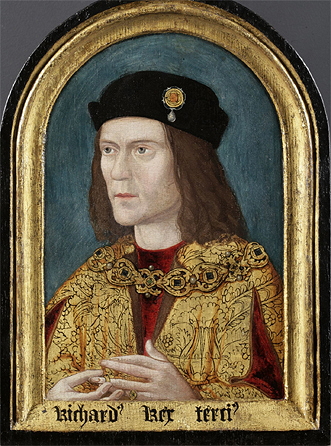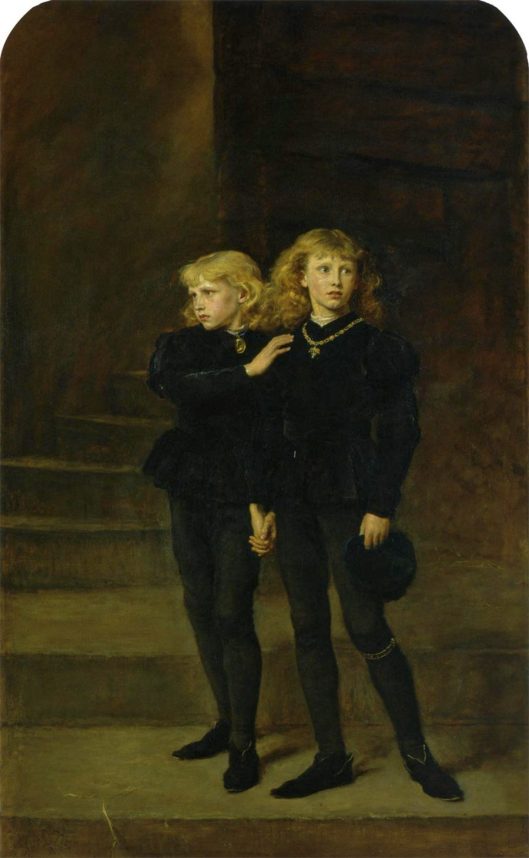Richard III (October 2, 1452 – August 22, 1485) was King of England and Lord of Ireland from June 26, 1483 until his death on August 22, 1485. He was the last king of the House of York and the last of the Plantagenet dynasty. His defeat and death at the Battle of Bosworth Field, the last decisive battle of the Wars of the Roses, marked the end of the Middle Ages in England.
Richard was born on October 2, 1452, at Fotheringhay Castle in Northamptonshire, the eleventh of the twelve children of Richard, 3rd Duke of York, and Cecily Neville, and the youngest to survive infancy.
His childhood coincided with the beginning of what has traditionally been labelled the ‘Wars of the Roses’, a period of political instability and periodic open civil war in England during the second half of the fifteenth century, between the House of York, who supported Richard’s father (a potential claimant to the throne of King Henry VI from birth), and opposed the regime of Henry VI and his wife, Margaret of Anjou, and the House of Lancaster, who were loyal to the crown.

In 1459, his father and the Yorkists were forced to flee England, whereupon Richard and his older brother George were placed in the custody of their aunt Anne Neville, Duchess of Buckingham, and possibly of Cardinal Thomas Bourchier, Archbishop of Canterbury.
Richard was created Duke of Gloucester in 1461 after the accession of his brother King Edward IV. In 1472, he married Anne Neville, daughter of Richard Neville, 16th Earl of Warwick (The King Maker). He governed northern England during Edward’s reign, and played a role in the invasion of Scotland in 1482.
Lord Protector
On the death of Edward IV on April 9, 1483, his 12-year-old son succeeded him as King Edward V. Richard was named Lord Protector of the Realm and at Baron Hastings’ urging, Richard assumed his role and left his base in Yorkshire for London.
On April 29 as previously agreed, Richard and his cousin, Henry Stafford, 2nd Duke of Buckingham, met Queen Elizabeth’s brother, Anthony Woodville, Earl Rivers, at Northampton.
At the queen’s request, Earl Rivers was escorting the young king to London with an armed escort of 2000 men, while Richard and Buckingham’s joint escort was 600 men. Edward V himself had been sent further south to Stony Stratford.
At first convivial, Richard had Earl Rivers, his nephew Richard Grey and his associate, Thomas Vaughan, arrested. They were taken to Pontefract Castle, where they were executed on June 25 on the charge of treason against the Lord Protector after appearing before a tribunal led by Henry Percy, 4th Earl of Northumberland. Rivers had appointed Richard as executor of his will.
After having Rivers arrested, Richard and Buckingham moved to Stony Stratford, where Richard informed Edward V of a plot aimed at denying him his role as protector and whose perpetrators had been dealt with.

Richard proceeded to escort the king to London. They entered the city on May 4, displaying the carriages of weapons Rivers had taken with his 2000-man army. Richard first accommodated Edward in the Bishop’s apartments; then, on Buckingham’s suggestion, the king was moved to the royal apartments of the Tower of London, where kings customarily awaited their coronation.
Within the year 1483, Richard had moved himself to the grandeur of Crosby Hall, London, then in Bishopsgate in the City of London. Robert Fabyan, in his ‘The new chronicles of England and of France’, writes that “the Duke caused the King (Edward V) to be removed unto the Tower and his broder with hym, and the Duke lodged himselfe in Crosbyes Place in Bisshoppesgate Strete.”
In Holinshed’s Chronicles of England, Scotland, and Ireland, he accounts that “little by little all folke withdrew from the Tower, and drew unto Crosbies in Bishops gates Street, where the Protector kept his houshold. The Protector had the resort; the King in maner desolate.”
On hearing the news of her brother’s April 30 arrest, the dowager Queen Elizabeth fled to sanctuary in Westminster Abbey. Joining her were her son by her first marriage, Thomas Grey, 1st Marquess of Dorset; her five daughters; and her youngest son, Richard of Shrewsbury, Duke of York.
On 10/11 June, Richard wrote to Ralph, Lord Neville, the City of York and others asking for their support against “the Queen, her blood adherents and affinity,” whom he suspected of plotting his murder. At a council meeting on Friday June 13, at the Tower of London, Richard accused Hastings and others of having conspired against him with the Woodvilles and accusing Jane Shore, lover to both Hastings and Thomas Grey, of acting as a go-between.
According to Thomas More, Hastings was taken out of the council chambers and summarily executed in the courtyard, while others, like Lord Thomas Stanley and John Morton, Bishop of Ely, were arrested. Hastings was not attainted and Richard sealed an indenture that placed Hastings’ widow, Katherine, directly under his own protection.
Bishop Morton was released into the custody of Buckingham. On June 16, the dowager Queen Elizabeth agreed to hand over the Duke of York to the Archbishop of Canterbury so that he might attend his brother Edward’s coronation, still planned for June 22.
King of England
A clergyman (Bishop Robert Stillington) is said to have informed Richard that Edward IV’s marriage to Elizabeth Woodville was invalid because of Edward’s earlier union with Eleanor Butler, making Edward V and his siblings illegitimate.
The identity of the informant, known only through the memoirs of French diplomat Philippe de Commines, was Robert Stillington, the Bishop of Bath and Wells.
On Sunday June 22, a sermon was preached outside Old St. Paul’s Cathedral by Ralph Shaa, declaring Edward IV’s children bastards and Richard the rightful king.
Shortly after, the citizens of London, both nobles and commons, convened and drew up a petition asking Richard to assume the throne. Richard accepted on 26 June 26 and was crowned at Westminster Abbey on 6 July 6. His title to the throne was confirmed by Parliament in January 1484 by the document Titulus Regius.
The princes, who were still lodged in the royal residence of the Tower of London at the time of Richard’s coronation, disappeared from sight after the summer of 1483.
Although after his death Richard III was accused of having Edward and his brother killed, notably by More and in Shakespeare’s play, the facts surrounding their disappearance remain unknown. Other culprits have been suggested, including the Duke of Buckingham and even Henry VII, although Richard remains a suspect.
After the coronation ceremony, Richard III and Anne set out on a royal progress to meet their subjects. During this journey through the country, the king and queen endowed King’s College and Queens’ College at Cambridge University, and made grants to the church.
Still feeling a strong bond with his northern estates, Richard later planned the establishment of a large chantry chapel in York Minster with over 100 priests. He also founded the College of Arms.




















